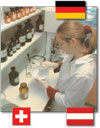

GD — Society for Dermopharmacy
 |
Issue 1 (2006) |
GD News
GD Press Campaign Relating to Sun Protection
UVA-Protection by Sunscreens – a Book of Seven Seals?
Excessive solar radiation entails - as is generally known - not only sunburn but can also cause long-term skin damage. The trigger for this phenomenon is besides short-wave ultraviolet radiation (UVB) also the long-wave UV-fraction of sunlight (UVA). Sunscreens providing a broad-spectrum protection should therefore not only safeguard from UVB- but also from UVA radiation. Unlike the UVB-protection which is determined by a standard method and declared as light protection factor there is no method beyond the Australian standard established for the identification of the UVA protection which has been generally recognized so far.
The Society for Dermopharmacy draws attention to this set of problems
in a scientific statement introduced at a press conference in Hamburg
on 26 January 2006. "It is considered to be verified at the present
time that besides the UVB also the UVA radiation is involved in the generation
of skin tumours", dermatologist professor Dr. Jean Krutman, director
of the Institut für Umweltmedizinische Forschung (Institute of Environmental
Medicine Research) at Heinrich-Heine University, Düsseldorf emphasized.
"Moreover, UVA radiation boosts the development of various other
light-conditioned dermatoses and accelerates skin-ageing", professor
Dr. Hans-Christian Korting of the Klinik für Dermatologie und Allergologie
(Clinic for Dermatology and Allergology) of Ludwig-Maximilians-Universität,
Munich, added.
insufficiently informative
"Sunscreens claiming to equally protect from UVA radiation should be correspondingly tested and declared", Dr. Joachim Kresken, president of the Gesellschaft für Dermopharmacy and owner of a pharmacy in Viersen, claims. At present this is in most cases effected by indicating whether a product fulfils the Australian standard. This condition is considered to be accomplished if a product reduces the permeability of the UVA-radiation by at least 90 percent in a particular lab model.
 16 journalists represented a distinguished panel composed of experts and public media to participate in the press conference organized by the GD in Hamburg on 26 February 2006. Further 58 editorial offices filed a request for the press handouts. |
Beyond this limit a further differentiation is not envisaged. The UVA
protection therefore remains independent from the level of the UVB protection
always at the same level. "When using a sunscreen with high light
protection factor towards UVB, a relatively high UVA dose without infringing
the standard may thus affect the skin without the user's noticing",
Kresken explained.
Therefore in the opinion of the Gesellschaft für Dermopharmazie besides
the Australian Standard also additional methods for the characterization
of the UVA-protection are recommended supplying more precise information
allowing thus a differentiation between different products. As the society
states this wish cannot yet be fulfilled at present. In fact, in the last
years several new methods for the determination of the UVA-protection
have been developed, however they are either too elaborate or not yet
sufficiently backed up in their significance.
still contested
The latter for example also applies to the method valid since February 2005 in Germany according to DIN 67502. This method determines the so-called UVA-balance, i. e. the relation between UVB and UVA protection of a product. The procedure is subject to criticism owing to the fact that the duration of the protection effect is not considered and no biological endpoint employed relevant for long-term skin damage caused by UVA-radiation. Also there is no recommendation to date on the minimum level of the UVA balance value of a sunscreen in order to attribute a sufficient UVA protection to it.
 Professor Dr. Jean Krutmann (right) informed at the press conference about new findings relating to photo-biological mechanisms of skin damage by UV-radiation. The acting GD-president Prof. Dr. Hans Christian Korting (left) explained the necessity of a consistent light protection by means of the clinic of UV-related skin damage. Following GD-president (mid) presented the GD position on test and declaration of UVA-protection by sunscreens. |
Owing to the - so far - still unsolved questions, the society recommends not to use the procedure for standard testing purposes at the time being. Incidentally, it is to be considered that the consumer may possibly be unable to cope if in future besides the light protection factor towards UVB in addition a UVA protection value established by which method ever would be declared. This is why on medium-term a practice-oriented procedure should be searched for providing the declaration of a protection factor and summarizes the protection performance towards UVA and UVB radiation in one value.
|
The GD position presented at the press conference on 26 January 2006 "UVA protection of Sunscreens" is available for download at the internet address www.gd-online. |
top